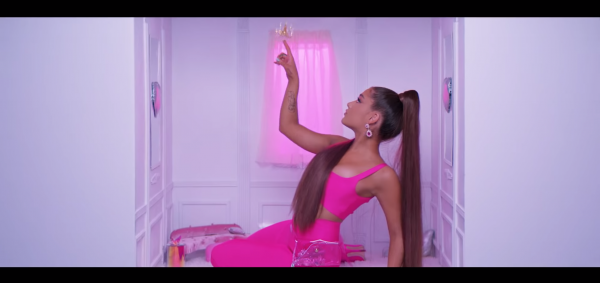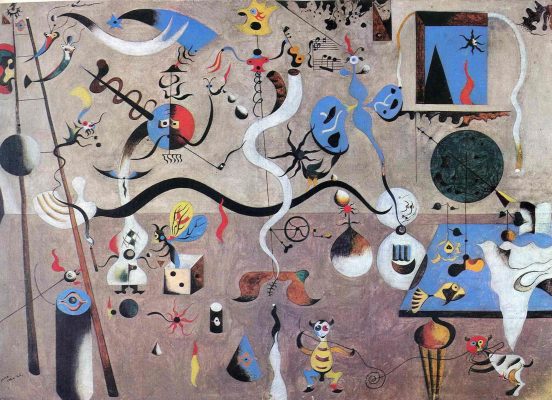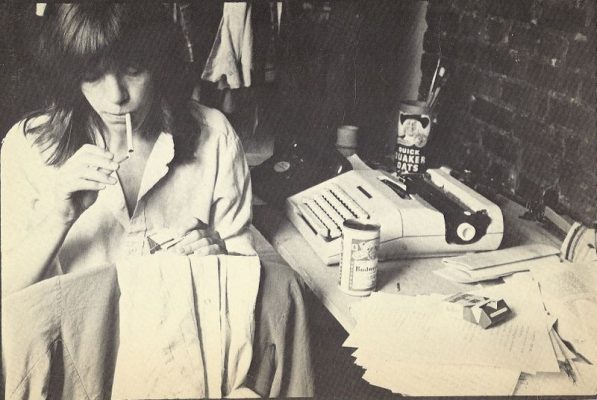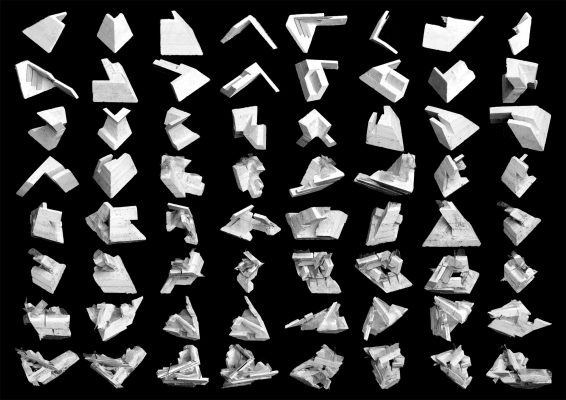‘Avoid me not!’ ‘Avoid me not!’
Narcissus
Let me describe a GIF I’ve been watching. A lot. Ariana Grande is dressed in hot pink—tight cropped vest and high waisted trousers. She is on her knees, leaning backwards, in a tiny room with white walls and a little curtain. Maybe it’s a doll’s house, maybe it’s a closet, maybe it’s a cage. Her trademark oversized ponytail, which seems to have been designed for the purpose of making her appear even smaller than she already is (in the world of Ariana worship, smallness is akin to godliness), splits at the top knot and falls in two directions. Half over her breast, half drawing a line south. With the index finger of her right hand she flicks a miniature chandelier that is dangling from the ceiling, making it swing lightly back and forth. GIFs are the internet’s present to erotics. The best ones, like this one, exist in a seamless loop, enabling the viewer to remain suspended indefinitely in a moment of aesthetic bliss. Flick, flick, goes Ariana, for a sweet eternity.
I’m aware that this is a dirty crush. (One shared by a lot of the world, admittedly, but since when did populism ever make anything cleaner.) My Ariana-lust is treated by certain friends with the sort of stretched tolerance usually reserved for the bad politics of elderly relatives. Which is another way of saying I just about get away with coveting a mirage of hyper-femme youth, sex, and tininess, because in the political and pansexual new dawn of queerness, at age 32 I seem to have become the equivalent of Stonehenge: a heritage lesbian artefact to be handled with curiosity and compassion. I could try to intellectualise my love of the flicking GIF, by claiming it in the lineage of queering. I could even try explaining the chandelier in relation to Roland Barthes’s ‘punctum’, which has always seemed to me an unfortunately dry metaphor for the clitoris, anyway: that small locus of power, the magnetic point of attention around which photographs, like certain bodies, are organised. But fuck it. I don’t want to take the cold shower of theory. I’m just really hot for this GIF.
The Ariana flicking sequence was sampled from the video for 7 Rings, a beautiful piece of music that reimagines Julie Andrews’s My Favourite Things in the style of the wealth-brag — a genre given a new lease of life, and a questionable new political dimension, in the current wave of pop feminism. 7 Rings is a song about a young woman making a shit-tonne of money, who has swapped Andrews’s silver-white winters that melt into springs for diamonds and lashes and ATM machines. ‘Whoever said money can’t solve your problems, must not have had enough money to solve em’, sings Ariana, drinking champagne from custom silver and pink bottles, surrounded by her friends — young women who are the beneficiaries of her largesse. She’s hot, she’s rich, she’s righteous. And she looks good. Really good. Her diamanté and acid rose wardrobe a million times better than the latex bunny outfit she was wearing back in 2017 — the sort of Hugh Hefner knockoff that you might find sharing a rail with a rubber maid’s uniform and a pair of crotchless knickers on one of Camden Market’s more depressing stalls. (Send me to a hell of men in silk pyjamas, but part of me was still into it.)
7 Rings isn’t the first time Ariana has left the door open for lesbian metaphor. There is a joyful scene in the 2018 video for God is a Woman, for instance, in which she straddles the planet, circles her hands over the northern hemisphere, causing a storm in the process, and then fingers the world. (There is a GIF for this, too. And yes, it’s saved on my phone.) And then there’s the video to thank u, next, in which lesbianism is used as the punchline at the end of an innuendo about the large proportions of her ex-fiancé’s dick. Sitting across from the actress Jennifer Coolidge, in a recreation of a salon scene from the film Legally Blonde, Ariana opens up to her confidant while having her nails done:
Ariana Grande: He was really cute. And it was really, really big.
Jennifer Coolidge: Well I’ve only gone out with one guy who had a really big … front tooth, and I liked it because he never got anything stuck in the front teeth. But have you ever gone out with someone who had no teeth at all?
Ariana Grande: No.
Queue the cogs starting to turn in millions of viewer’s minds. If big teeth equals big dick, then no teeth equals…. OH! Using the vagina’s supposed ‘lack’ as a foil for discussing an abundance of D is a cheap shot. And this, from the woman responsible for the existence of the expression ‘Big Dick Energy’. (I’m still holding out for the day ‘massive pussy’ is a byword for confidence and sex appeal.) So deep is my love for Ariana, however, that I was willing to let it slide.
Considering the pleasure I get watching Ariana GIFs that have been sampled for their sapphic allusion, and how low I have evidently set the bar when it comes to morality/politics/standards, why did I balk at the overt lesbian signalling in the video to 2019’s Break Up With Your Girlfriend? It’s not my favourite of her songs — a story about female heterosexual rivalry, in which Ariana is out to steal another woman’s man — but she could sing anything and make it sound good. She has the closest thing to a vocal vibrator: moving between otherworldly whispers and how-did-she-know-how-to-hit-that high notes. She delivers Break Up With Your Girlfriend with a combination of Rihanna-influenced hauteur, and flashes of the four octave range that makes her sound like she’s been inhabited by the same unhinged singing demon that lives inside Mariah Carey’s lungs.
In the end it wasn’t the song I snagged on, but the video: in particular, its invocation of the lesbian narcissus. The action takes place at a party in a mansion, where the actors, the architecture, and the wardrobes look like a fantasy of wealth and luxury dreamt up by people in a boardroom at River Island HQ. Ariana is wandering around the party in a little black dress, feeling horny, listless, jealous, and imperiously self-confident. She is also casting you-know-you-want-this glances in the direction of a guy in a black leather jacket with a Desperate Dan jaw, who looks like he’s been cut straight from the ‘men’s partywear’ section of the catalogue. Mr. River Island, however, is already in a relationship. And guess what? His girlfriend looks like a less remarkable clone of Ariana: same enormous ponytail, same little black dress, same petite body, same winged eyeliner and sheening vinyl skin. Throughout the video the viewer is encouraged to buy into the narrative that Ariana is ready to dust her rival. By the look on Mr. Island’s face he knows it, and the song lyrics even say it. (‘You could say I’m hatin if you want to, but I only hate on her cause I want you’.) Except there’s a twist. At the end of the video, when Ariana swims over to the couple in the pool ready to finally snatch River Island for herself, she turns to snog her clone instead — a climax that has the sum total of sweet FA to do with the story told by the lyrics.
With that kiss, the ice water of theory came pouring over me. The video’s use of the ‘lesbian narcissism’ trope made me do the one thing I really don’t want to: analyse my crush, and consider it in the depressing lineage of mass-marketed lesbian chic. One of the more complicated features of queer life is the speed at which anything can become political. Kiss your lover in public, and deal with becoming a sexual spectacle; listen to the person on the phone who assumes that your partner is a man, and decide whether to retreat to the closet or become a minor civil rights activist. It’s not all bad. A heightened awareness, and a habit of constantly reading between the lines, certainly sharpens a person’s mind. But it can be tiring, and it often leads to a way of appraising the world that Eve Sedgwick called ‘a hermeneutics of paranoia’: constantly proving how rotten everything is, like picking up pretty stones in order to show there’s a dog shit lurking beneath each one of them. ‘The main reasons for questioning paranoid practices are other than the possibility that their suspicions can be delusional or simply wrong’, Sedgwick wrote. I take this to mean, yes: the shit is usually there. But in constantly proving our worst fear right, do we continue to place it centre stage, and at what cost? Besides, shit-hunting for structural inequality is hardly an aphrodisiac.
Break Up With Your Girlfriend sent me right back down the path to paranoid thinking. ‘Lesbian narcissism’ is a popular theme among directors of music videos, and the trick to getting it right is to muddy the waters of lesbian eroticism with self-love, thus enabling a singer such as Ariana to hit multiple markets at once: gaining widespread attention for appearing sexually risqué, appealing to her LGBTQ fanbase, and also playing the you-go-girl! feminist who puts her own needs before the wants of any man. (The irony is not lost on me that this latter ambition is something lesbians manage to achieve largely without trying, but there you go.) Among my personal favourites in the lesbian narcissism hall of fame is Mel B’s 2013 video For Once in My Life, in which she snogs herself in the hallway at a suburban house party, then parades out into the street, apparently liberated, while wearing a white vest, leather shorts, and a weird, cobwebby corset. (I’m not sure how to categorise this dyke-ish outfit, but suffice it to say: big look.) ‘For once in my life I’m gonna let go, for once in my life, I’m gonna do it for me!’
Recent trope-users include Selena Gomez, who plays the entire central cast at a high school in the 1970s for the 2017 video Bad Liar: school girl with a crush, male teacher, and female teacher and love object with Farah Fawcett hair. Much like Break Up With Your Girlfriend, Bad Liar directs the viewer into thinking little Selena is flirting with old man Selena — a disturbing device in its own right, but that is an essay for another day — until the final scene, where we see her lying in bed, drawing love hearts in her diary around Selena Fawcett’s face. In 2018, Rita Ora released the bi-sexual-themed song Girls, with a video that includes models styled to look exactly like… wait for it… none other than Rita Ora herself, with the same haircut and clothes. These ones even go so far as to lick their own reflections in the mirror. The song has a guest rap from Cardi B, who bows before the gods of the genre with the following line: ‘I ain’t got to introduce myself, I’m too sexy I seduce myself.’
Lesbian narcissism is an off-shoot of the ‘non-lesbian’ genre of cultural production, which has been a running topic of conversation between my friend Tina and me for a number of years. (We use ‘non’ to denote the absence or negation of lesbianism, even as lesbianism is signalled, rather than ‘un’, which would suggest a much more straightforward declaration that the subject is simply not lesbian at all.) ‘Just wanted to check in to make sure you’ve witnessed the lesbian narcissus content in Ariana’s vid?’, Tina messaged me, throwing the paranoid searchlight in my direction. Non-lesbian, as we define it, is a term for celebrities who base their image on a kind of panto-dyke: white vests, chains, tartan checks, car grease, punk hair. They look like lesbians, dress like lesbians, act like lesbians, and even get on the cover of lesbian interest magazines. The only thing missing is the fact that they are not actually lesbians, or else have served many-a-woman breakfast in bed with a nondisclosure agreement the morning after. Whole careers can be built on non-lesbianism. Pink, for example, is an expert in the field. She’s been rocking the sixth form statement coming-out haircut for the best part of twenty years, and she is not averse to dyke-baiting. (Her cover feature for Diva magazine in December 2008 ran with the headline ‘SINGLE AGAIN.“ALL MY FRIENDS SAY C’MON, ADMIT IT, YOU’RE A DYKE”’.) Shout out to TaTu, of course, whose manager Ivan Nikolayevich Shapovalov really changed the game by making two children snog on camera while pretending to be a couple.
Over the past few years public opinion towards queerness has certainly changed. Rita Ora and Cardi B, for example, are both openly bisexual, and thus break the old rule of thumb for non-lesbianism. Ariana has also publicly courted queerness by declaring that ‘sexuality is fluid’. But whatever the personal politics or sexual preferences of any given performer, there is clearly still a bald commercial incentive at play in invoking the lesbian narcissus, the existence of which makes it near impossible to watch a video such as Break Up With Your Girlfriend without lifting Sedgwick’s stones. Obviously it’s gross to think of the way that lesbianism is used as heterosexual foreplay and peddled for financial ends. I learned this depressing lesson early — along with why it’s not usually a good idea to try and game the heterosexual system. At my sixth form ball there was a kissing competition, and the winner, decided by clap-o-metre, won a bottle of wine. I wanted that wine, and I knew when I dragged my reluctant girlfriend on stage it was as good as mine. We bashed teeth, but no matter — the crowd cheered us to victory. I drank the wine, I hated the bastards for clapping, and then I puked.
The fact of the matter is that straight people love to see two women kiss. I don’t write this with any joy: Pornhub’s annual statistics, for the past four years no less, have listed ‘lesbian’ as the top global search term. Given that in 2018 Pornhub received 33.5 billion visits to the site — which the company proudly explains is equivalent to ‘the populations of Canada, Poland, and Australia every day’ — this speaks to the likes of a pretty large portion of the global population. Add to this something I discovered when listening to The Butterfly Effect, Jon Ronson’s illuminating podcast on the porn industry in the digital era: unlike ‘gay’ videos, ‘lesbian’ ones are typically considered by the industry as a sub-category of heterosexual content. Which is another way of saying, the more mass-market-lesbian something appears, the less it has anything to do with lesbianism.
In her 1995 polemic Lesbians are so chic… that they don’t really exist at all, Laura Cottingham eviscerated the commercial co-option of the lesbian identity. She reserves a particularly strong batch of vitriol for Madonna, who Cottingham says has found ‘that manipulating the public’s anxiety about lesbianism produces a marketable effect.’ The book was written before Madonna snogged Britney Spears on stage at the MTV Video Music Awards in 2003, although I imagine when that did happen, it sent Cottingham on a stone-lifting exercise like never before. Madonna had, however, released the coffee table volume Sex in 1992, which contained photographic stories of erotic encounters, including the singer in the middle of a lesbian three-way. (Sex reached the top of the New York Times best-seller list, and today is still the owner of perhaps the least sexy accolade going: fastest-selling coffee table book ever.)
Lesbians are so chic… is not without its flaws. There are times when Cottingham’s attempts to divest from heteropatriarchy lead her close to ‘queer policing’: the you’re not queer enough/ woman enough/ lesbian enough/ haven’t suffered enough or in the right way argument that is often the first step on the path to bigotry. (In recent years, a related line of thinking has fuelled the rise of transphobia; it’s also used as a tool by unscrupulous lovers for manipulating people into tolerating all kinds of crappy behaviour in the name of queerness.) But Cottingham does throw up some insightful gems. Among them are the extraordinary lengths TV and film producers have gone to, in order to simultaneously exploit and erase lesbianism on screen. Perhaps the most Byzantine example she cites is Rejoined, an episode of Star Trek: Deep Space Nine from 1995, in which a kiss between Dax and Kahn, two alien women belonging to the Trill species, actually turns out to be straight: ‘a long kiss between their respective symbiants who – surprise, were once married as man and woman.’ Not only are the women heterosexual lovers from a past life, who have somehow managed to reunite, they are also barred by the laws of the society to which they belong from ever being together. Illegal, negated, alien, yet still snogging: surely the pinnacle of non-lesbian achievement.
Cottingham writes that ‘one of the key features of contemporary lesbian chic is to keep the lesbian exclusively fictionalised; that is, to disallow any steady appearance of actual lesbians, of lesbianism as self-contained, stable, steadily lived and culturally incorporate.’ The effect of this is to impress upon lesbians that ‘we are a people with no permanence, no place, no visible history.’ Lesbian stories are told as one-night stands, illicit fantasies wheeled-out for their scream-face emoji value; and lesbians are typically shown as lone wolves, without a lesbian social circle or culture to belong to. (In the case of Dax and Kahn, even their bodies are not their own.)
Because I am hopelessly devoted, I have tried to make peace with Ariana’s clone snogging, by thinking about the ways in which ‘sameness’ can be a virtue. The French, for instance, use the term un amour fusionnel, to describe lovers whose identities mingle to the extent that they become fused: a type of romantic bond with the potential to upset normative expectations of selfhood. (If heteronormativity encourages people to assume their place in society in relation to their ‘opposite’ gender, the ‘fuser’ loves their partner to the extent that they actually become them.) Within lesbian culture the phrase ‘urge to merge’ is often dispatched with lightly derogatory intent, to describe lesbian couples who start dressing the same, living together, and generally becoming inseparable. To my mind, the negativity attached to the phrase is a vestige of internalised homophobia. Personally I think it’s romantic, and, like amour fusionnel, could be seen as a quiet and loving kind of insubordination in a society obsessed with the identity of the individual. But in the end I am forced to admit that clone snogging is no love fusion, or urge to merge. It’s not, to quote the Spice Girls, a case of two become one. Clone snogging is the bizarre but logical nadir of a visual culture that celebrates lesbianism only insofar as it’s packaged as an isolated sexual act, an unexpected twist to the plot-line. What could be more isolated, what could invoke less of a culture, a history, a community, or the bonds of friendships and love relationships, than snogging your body double?
When faced with all these stones to lift, the GIF of Ariana in the closet, happily flicking away at that little golden chandelier, is a semiotic balm. In part, I enjoy it because whoever made it has put a lesbian twist on a heterosexual product, thus reversing the usual order of service. Most of all, I enjoy it because it’s pretty much one of the rudest things I’ve seen in ages. It’s a metaphor, of course — and not a very subtle, sophisticated, or complicated one — for clit worship.




